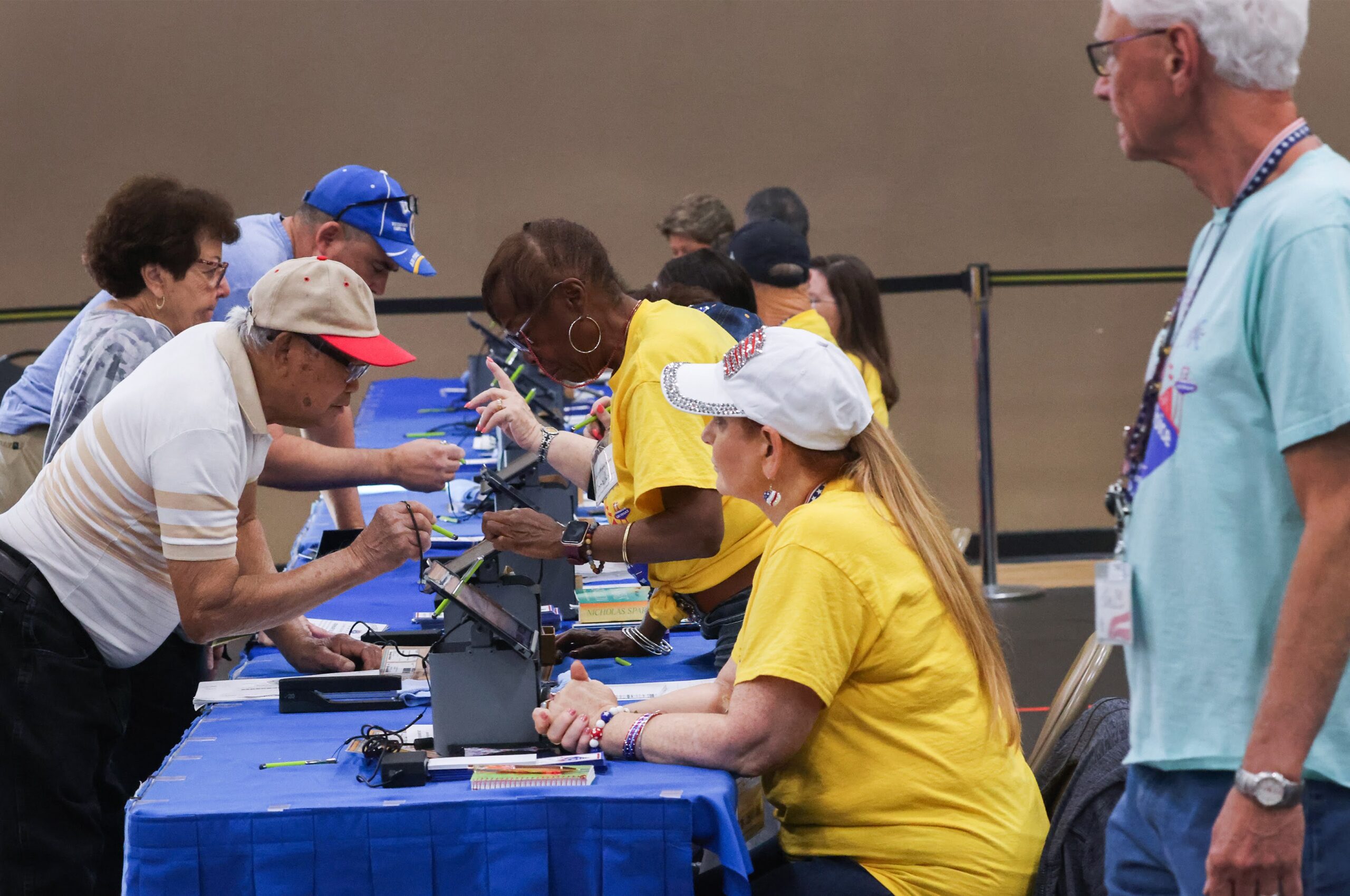Analysis: Nevada primary turnout down, but mail voting again reigns supreme

Turnout in last week’s state primaries dropped significantly from the 2020 and 2022 primaries, with fewer Nevadans participating across almost all counties.
As of Friday morning, about 380,000 votes had been counted in the primary, a decrease of roughly 20 percent from the past two cycles. Despite the dropoff, voting by mail continued to dominate, as a greater share of Democrats and Republicans chose to vote by mail than two years ago, while the share of in-person voting decreased.
Election analysts said the lack of competitive statewide primaries — especially on the Democratic side — likely dampened turnout.
Although the turnout rate decreased this year, it still marks a significant increase in the raw number of participating voters compared with primaries held before 2020, the first election after the state launched automatic voter registration and universal mail ballots. This year’s primary saw the third-highest number of votes cast since 1998 (the earliest year on record), trailing 2020 and 2022.
However, the 19 percent overall turnout rate, which the state defines as the percentage of active registered voters who cast ballots, was the lowest since 2016. The introduction of automatic voter registration in 2020 led to a surge in registered voters, but many of them are registered as nonpartisans, who cannot vote in primaries for partisan races.
The Nevada Independent analyzed primary turnout as of Friday morning, less than two days before all mail ballots must be received to be counted. Historically, little changes at this point in the process — in the 2022 election, about 3,000 mail ballots in Clark and Washoe counties were received on the final two days, according to data from the secretary of state’s office.
Primary turnout is not predictive of general election trends because primary voters are much more engaged and informed than the general electorate, according to election analysts.
In an interview, Secretary of State Cisco Aguilar suggested that the dropoff in participation rate may be because people were focused on the state’s presidential primary in February, which had record turnout for a presidential nominating contest, and may not be choosing to engage in elections without the presidential race on the ballot.
He also said that a lack of competitive statewide races — the only statewide race was the GOP primary for U.S. Senate, which Sam Brown won in a landslide — may have contributed to the decrease. The 2022 primary, by contrast, had several high-profile statewide primaries, including the GOP contests for governor, U.S. Senate and secretary of state.
Aguilar added that his office prioritized other election-related issues, such as the rollout of a new top-down voter database and recruitment of poll workers, over voter engagement.
“When you talk about voter turnout and civic engagement, that falls on the candidates, and it falls on the major political parties to get their bases energized,” Aguilar said.
Mail ballots continue rise in popularity
Statewide, about 65 percent of voters cast ballots by mail, up from 57 percent two years ago. More than 74 percent of Democrats voted by mail, compared with roughly 68 percent two years ago.
Notably, more than half of GOP primary voters cast mail ballots in 2024 after 43 percent did so in 2022.
The increase in mail ballot use comes as Nevada Republicans have toned down their opposition to the voting method, which was the source of conspiracies related to the 2020 election.
In the 2022 primary, Adam Laxalt, the GOP nominee for U.S. Senate, blasted the introduction of universal mail voting and falsely accused it of contributing to mass voter fraud. Jim Marchant, the Republican candidate for secretary of state, also called for the state to end mail voting. Marchant ran for Senate this year but finished a distant third.
This year, GOP candidates were not nearly as antagonistic toward the voting method. Almost all Republican candidates were mum on whether mail ballots led to fraud and some have changed their stance from two years ago.
Take Mark Robertson, the GOP candidate for the 1st Congressional District, for example.
While running in the same race in 2022, his campaign website called for a congressional inquiry into the potential risks of widespread mail voting. This year, though, he urged voters to embrace mail voting to increase his chance of winning. Robertson received about 2,000 more votes in the primary than he did two years ago, though it’s unclear how many of these votes were cast by mail.
David Damore, a political science professor at UNLV, said it is uncertain if this trend will continue into the general election because of the unpredictability of former President Donald Trump.
“You didn't have anybody campaigning against it like you did in 2020, and ultimately convenience is going to weigh out on this,” Damore said. “The general election, you may have a candidate campaigning against mail ballots.”
Trump has recently endorsed any legal voting method ahead of the general election, just four months after inaccurately saying mail ballots lead to “crooked elections.” The Trump campaign has also filed lawsuits in Nevada over the state’s allowance of counting mail ballots after Election Day and alleged counting of non-postmarked mail ballots.
Jeremy Hughes, a Nevada Republican strategist, said he expects GOP hesitance about the method to fade.
“As it becomes more common and voters get more comfortable with it, it's only going to increase,” Hughes said.
Clark County
Turnout was much lower in Clark County than two years ago.
Around 234,000 Clark County voters participated in this year’s primary, a decrease of more than 50,000 from 2022 and 70,000 from 2020. The turnout rate was around 16.4 percent, the lowest mark since 2016, though there are far more registered voters because of automatic registration.
This decrease came despite surges in turnout for municipal elections because of a 2019 law that moved municipal races away from odd-numbered years.
More than 72,000 people took part in the Las Vegas mayoral race as of Thursday afternoon, compared to about 26,000 when Carolyn Goodman cruised to re-election five years ago. And in two of the three city council seats up for grabs, turnout more than doubled from 2019.
Still, turnout dropped significantly compared with the last two cycles — which Damore said might be because of the lack of a high-profile statewide race, even with mayoral candidates spending hundreds of thousands of dollars on local TV ad buys.
“Even though you had some interesting races down ticket, they weren't enough to draw people there to participate without something at the top of the ticket, like a competitive governor's race or a competitive Senate primary,” Damore said.
Hughes also noted that many of these municipal candidates do not have the money to make significant investments into voter outreach, so the lack of well-funded, competitive statewide races would result in less voter engagement.
Despite the significantly lower turnout, mail voting in Clark County was more popular than in 2022.
Sixty-three percent of Clark County votes were by mail, up from 55 percent in the 2022 primary, though that is lower than the 74 percent of people who voted by mail in February’s presidential primary.
In a legislative meeting last month, Clark County Registrar Lorena Portillo said the turnout breakdown in this year’s elections would play a key role in determining how the county allocates its resources going forward, adding that it may downsize in-person election staff if mail ballots continue to be the dominant voting method.
Stephanie Wheatley, a Clark County spokesperson, said last week that it would be premature to say how the primary’s results would affect future election planning.
Washoe County
Washoe County also saw a big dropoff in turnout this cycle.
In 2020 and 2022, more than 95,000 people cast ballots in the Northern Nevada county. This year, that number fell to around 80,000, bringing the total turnout to 24.4 percent.
A sign of the low turnout? Only 7,000 more Washoe County votes were cast this year than in the 2010 primary election, a year with a high-profile Senate GOP primary when there were an estimated 75,000 fewer county residents.
The low turnout was evident in some local races. In the Assembly District 27 Democratic primary between lawyer Alex Velto and community organizer Heather Goulding, about 3,900 people had voted as of Friday morning, compared with the roughly 4,500 votes cast in the same race in 2022.
However, the county surpassed expectations on mail voting turnout.
Interim Registrar Cari-Ann Burgess told state lawmakers last month that the county expected more than half of voters to participate by mail. As of Friday morning, 70 percent of voters cast mail ballots, after about 59 percent did so two years ago.
The county is planning to unveil new technology before the general election to expedite ballot processing. The new ballot sorting machine will automatically sort envelopes by precinct for all votes not cast in person on Election Day (mail votes, early votes and ballots left at drop boxes).
